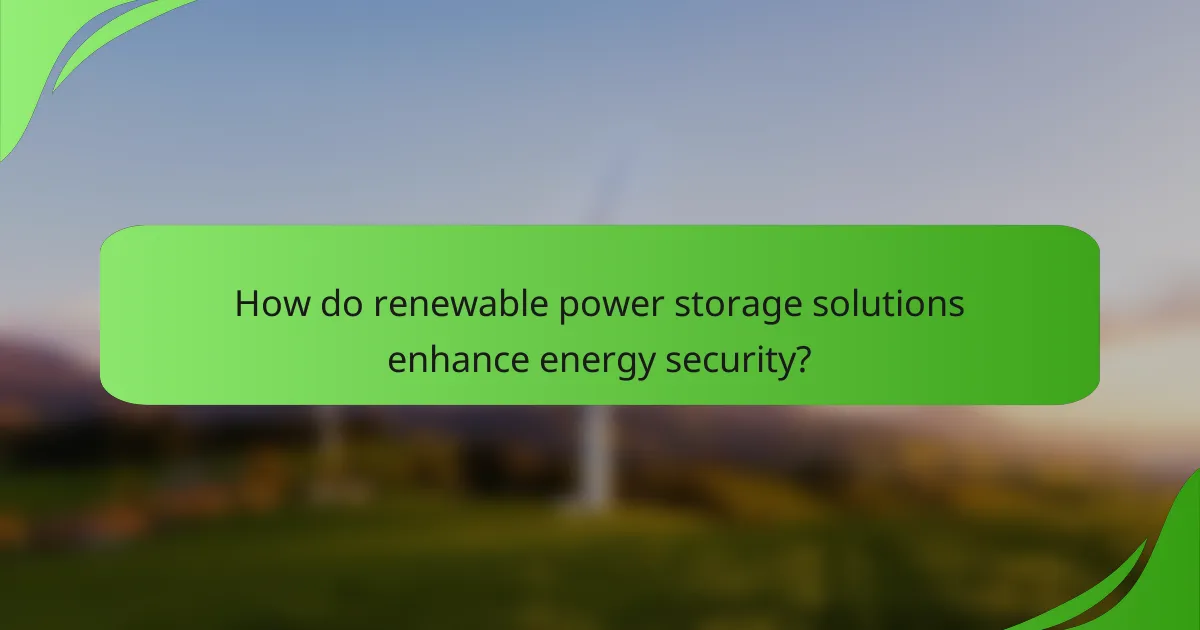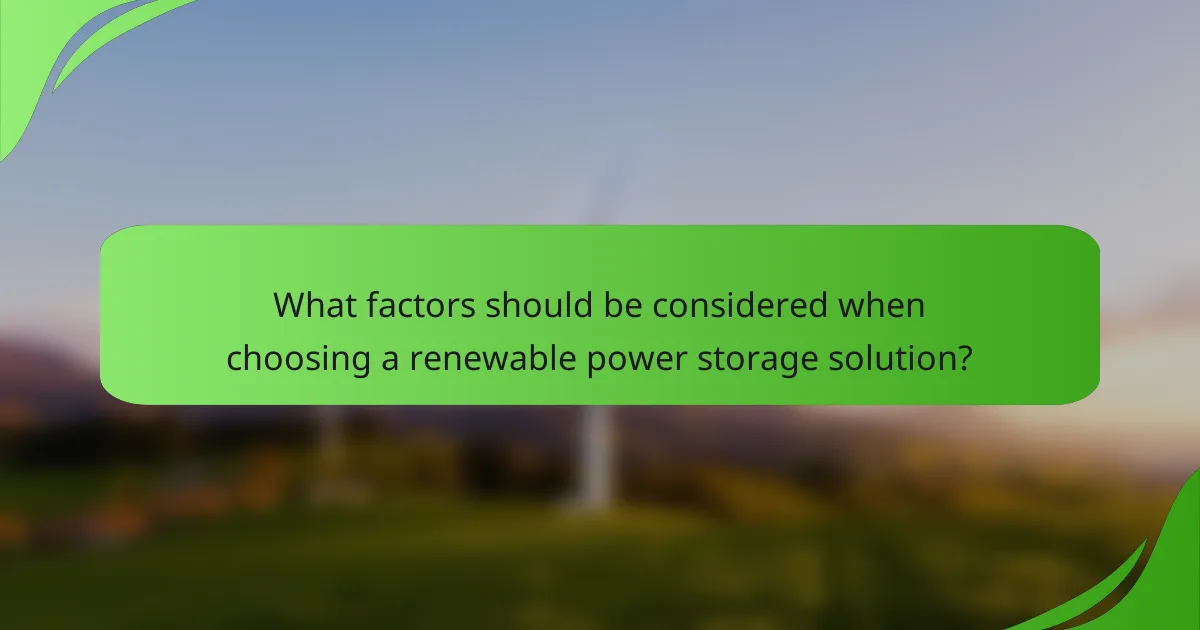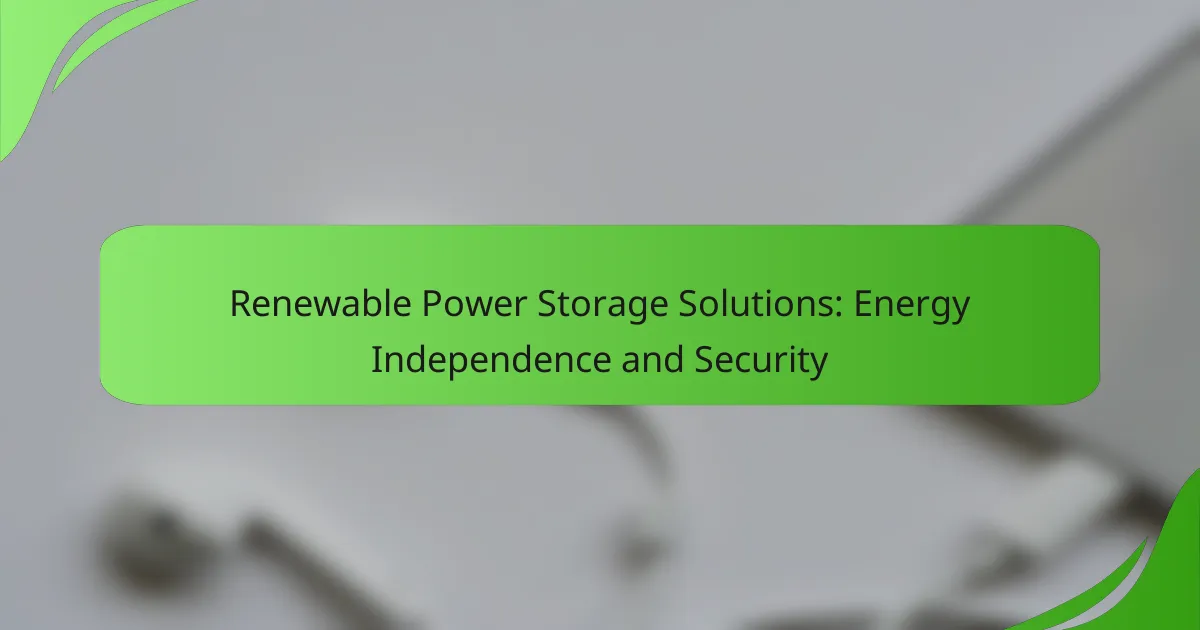Renewable power storage solutions are essential for achieving energy independence and enhancing security by ensuring a consistent supply of energy generated from renewable sources. Technologies such as lithium-ion batteries, flow batteries, and pumped hydro storage offer unique advantages, allowing for the storage of excess energy during peak production times for use during high demand. By reducing reliance on imported fossil fuels, these systems contribute to a more resilient energy grid and a sustainable future.

What are the best renewable power storage solutions for energy independence?
The best renewable power storage solutions for energy independence include technologies that effectively store energy generated from renewable sources, allowing for consistent power availability. Key options include lithium-ion batteries, flow batteries, compressed air energy storage, pumped hydro storage, and thermal energy storage, each with unique advantages and considerations.
Lithium-ion batteries
Lithium-ion batteries are widely used for energy storage due to their high energy density and efficiency. They are suitable for residential and commercial applications, providing quick response times and scalability. However, they can be costly, and their lifespan may be limited to a few thousand charge cycles.
When considering lithium-ion batteries, look for systems with robust management software to optimize performance and lifespan. Common applications include home solar systems and electric vehicles, where they can store excess energy for later use.
Flow batteries
Flow batteries offer a unique approach to energy storage by using liquid electrolytes that flow through the system. This design allows for easy scaling and long discharge times, making them suitable for large-scale energy storage applications. They are particularly effective for balancing intermittent renewable energy sources like solar and wind.
While flow batteries have a lower energy density compared to lithium-ion batteries, they can be cycled many more times without significant degradation. This makes them a viable option for grid storage and renewable energy integration.
Compressed air energy storage
Compressed air energy storage (CAES) involves storing energy by compressing air in underground caverns or tanks. When energy is needed, the compressed air is released to drive turbines and generate electricity. CAES systems can provide large-scale storage and are particularly effective for balancing supply and demand on the grid.
However, CAES requires significant infrastructure and is best suited for locations with suitable geological formations. Efficiency can be a concern, as some energy is lost during the compression and expansion processes.
Pumped hydro storage
Pumped hydro storage is one of the most established methods for large-scale energy storage. It works by moving water between two reservoirs at different elevations. During periods of low demand, excess energy is used to pump water uphill, and during high demand, the water is released to generate electricity.
This method is highly efficient and can provide significant storage capacity. However, it requires specific geographical conditions and substantial upfront investment, making it less feasible in urban areas.
Thermal energy storage
Thermal energy storage systems store energy in the form of heat, which can be used later to generate electricity or provide heating. Common methods include molten salt storage and ice storage systems. These systems are particularly effective for concentrating solar power plants and can help manage energy loads during peak demand times.
Thermal storage can be cost-effective and has a long lifespan. However, it may not be suitable for all applications, particularly where rapid energy dispatch is required. Understanding the specific energy needs and infrastructure is crucial when considering thermal storage options.

How do renewable power storage solutions enhance energy security?
Renewable power storage solutions significantly enhance energy security by providing a reliable and consistent energy supply, reducing dependence on imported fossil fuels, and improving the resilience of the energy grid. These systems store excess energy generated during peak production times for use during periods of high demand or low generation.
Stabilizes energy supply
Renewable power storage systems, such as batteries and pumped hydro storage, stabilize energy supply by balancing the intermittent nature of renewable sources like solar and wind. When energy production exceeds demand, these systems store the surplus, ensuring that energy is available when production drops.
For example, a solar power system can generate excess energy during sunny days, which can be stored and used during cloudy periods or at night. This capability helps maintain a steady energy supply, reducing fluctuations that can disrupt service.
Reduces reliance on fossil fuels
By integrating renewable power storage solutions, communities can significantly reduce their reliance on fossil fuels. Stored renewable energy can replace fossil fuel-generated electricity during peak demand times, minimizing the need for gas or coal plants.
In regions where renewable energy is abundant, such as areas with high solar or wind potential, storage systems can provide a more sustainable energy mix. This transition not only lowers carbon emissions but also enhances energy independence by utilizing local resources.
Facilitates grid resilience
Renewable power storage enhances grid resilience by providing backup power during outages and helping to manage load fluctuations. This capability is crucial for maintaining service continuity, especially during extreme weather events or unexpected demand spikes.
For instance, during a storm that disrupts traditional power sources, stored energy can be deployed to keep critical infrastructure operational. Additionally, storage systems can support grid stability by providing ancillary services, such as frequency regulation, which helps maintain the balance between supply and demand.

What factors should be considered when choosing a renewable power storage solution?
When selecting a renewable power storage solution, key factors include cost-effectiveness, capacity and scalability, and environmental impact. Each of these elements plays a crucial role in ensuring the chosen system meets both current and future energy needs efficiently.
Cost-effectiveness
Cost-effectiveness is a primary consideration when evaluating renewable power storage solutions. This includes not only the initial investment but also ongoing maintenance and operational costs. Comparing the total cost of ownership over the system’s lifespan can provide a clearer picture of its financial viability.
For example, lithium-ion batteries may have a higher upfront cost but offer longer lifespans and lower maintenance expenses compared to other technologies like lead-acid batteries. It’s essential to calculate the cost per kilowatt-hour (kWh) stored to make informed decisions.
Capacity and scalability
Capacity refers to the amount of energy a storage system can hold, while scalability indicates how easily the system can be expanded to meet growing energy demands. When choosing a solution, assess both current energy needs and future growth potential.
For instance, a residential solar battery system should have enough capacity to store energy for daily use, but it should also allow for additional units to be added as energy consumption increases. Systems that offer modular designs can be particularly advantageous for adapting to changing requirements.
Environmental impact
The environmental impact of renewable power storage solutions is increasingly important. Consider the materials used in manufacturing, the energy consumed during production, and the recyclability of the components at the end of their life cycle.
For example, while lithium-ion batteries are widely used, their production involves significant resource extraction and energy use. Evaluating alternatives, such as flow batteries or sodium-ion batteries, may offer lower environmental footprints. Additionally, check for compliance with local regulations regarding hazardous materials and recycling practices.

What are the local incentives for renewable power storage in the United States?
In the United States, various local incentives exist to promote renewable power storage, enhancing energy independence and security. These incentives include federal tax credits, state-specific rebates, and net metering policies that encourage the adoption of energy storage solutions.
Federal tax credits
The federal government offers tax credits that significantly reduce the upfront costs of renewable power storage systems. Currently, the Investment Tax Credit (ITC) allows homeowners and businesses to deduct a substantial percentage of the cost of installing solar energy systems, which can include battery storage. This credit can cover a significant portion of the investment, making it more accessible for many consumers.
To qualify for the ITC, the system must be installed on your property and meet specific requirements set by the IRS. It’s advisable to consult with a tax professional to ensure compliance and maximize the benefits.
State-specific rebates
Many states provide additional rebates for renewable power storage systems, which can further lower the cost for consumers. These rebates vary widely by state, with some offering cash incentives based on the capacity of the installed battery system. For example, states like California and New York have robust programs that can provide thousands of dollars in rebates.
To take advantage of these state-specific rebates, check with your local energy authority or utility company for available programs and eligibility requirements. Timing is crucial, as funding for these programs can be limited and may change annually.
Net metering policies
Net metering allows homeowners with renewable energy systems to sell excess energy back to the grid, providing a financial return on their investment. This policy can significantly enhance the economic viability of energy storage systems, as it enables users to offset their energy costs while contributing to grid stability.
Each state has different net metering regulations, including how much you can earn for excess energy and the terms of the agreement. It’s essential to understand your state’s policies to maximize the benefits of net metering alongside your renewable power storage system.

What are the emerging trends in renewable power storage technologies?
Emerging trends in renewable power storage technologies focus on enhancing efficiency, capacity, and sustainability. Innovations such as solid-state batteries and advanced flow batteries are gaining traction, promising improved energy independence and security for renewable energy systems.
Advancements in solid-state batteries
Solid-state batteries represent a significant leap in energy storage technology, utilizing solid electrolytes instead of liquid ones. This shift enhances safety by reducing flammability risks and allows for higher energy densities, which can lead to longer-lasting power sources for electric vehicles and grid applications.
These batteries are still in the development phase, with companies exploring various materials and manufacturing processes. The potential for solid-state batteries includes charging times that could be reduced to minutes and lifespans extending beyond a decade, making them a promising option for renewable energy storage.
When considering solid-state batteries, keep in mind the trade-offs. While they offer many advantages, the current production costs are higher than traditional lithium-ion batteries. As technology matures and economies of scale are achieved, prices are expected to decrease, making them more accessible for widespread use.
